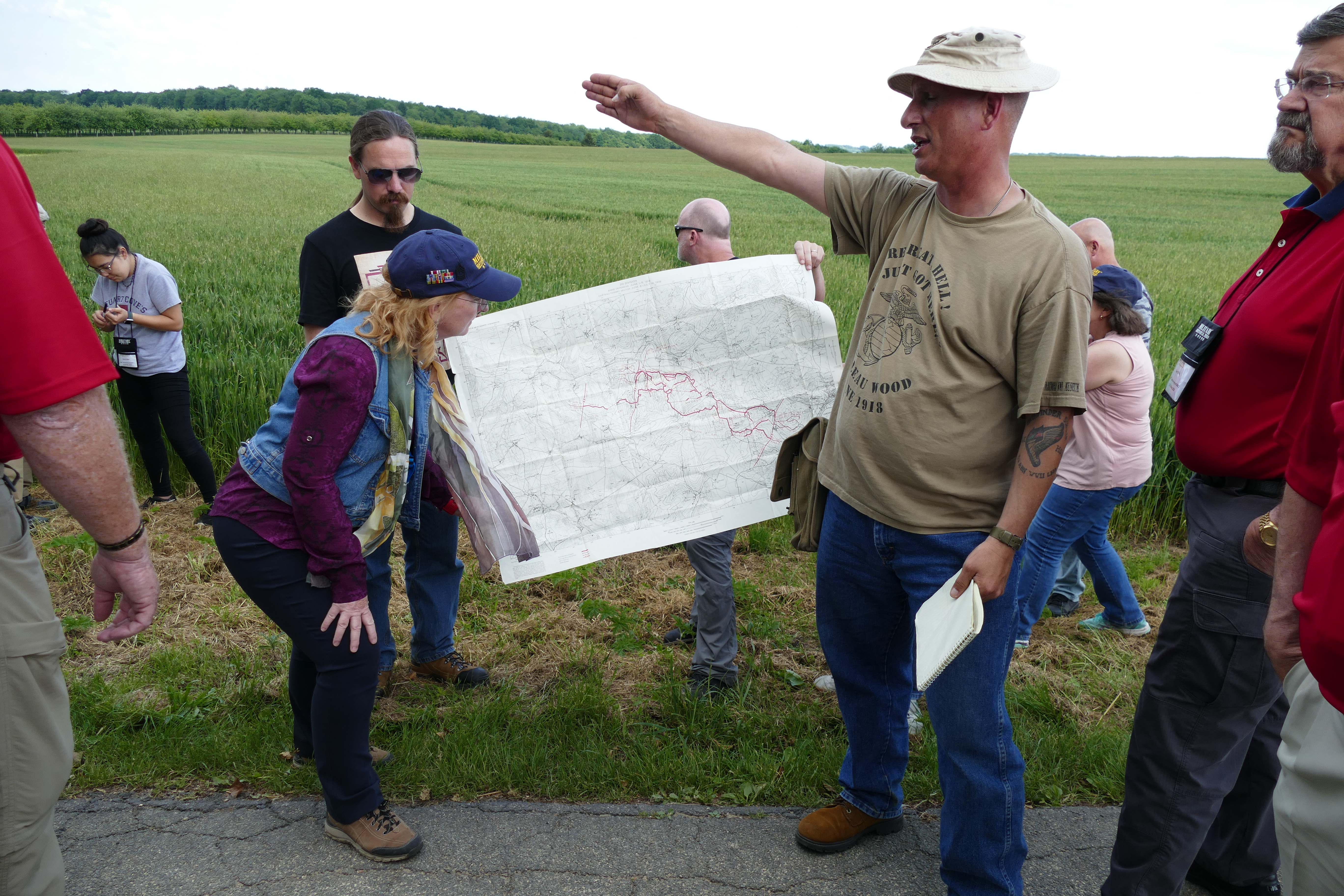Blog 01/29/2024 - MHT Movie Review "Napoleon"
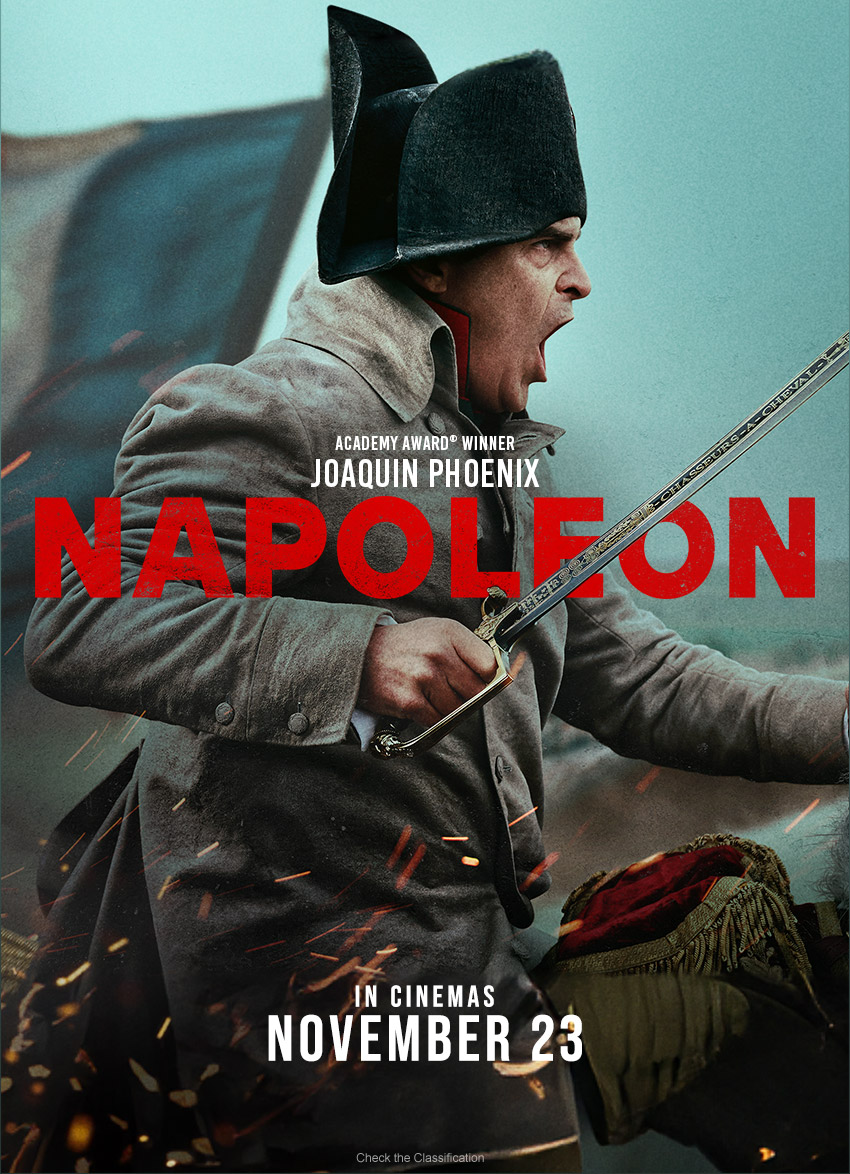
Ridley Scott & “Napoleon”…what was not to like…well unfortunately a lot! Most reviews praise how well the films battle sequences were shot; I was hoping for more. Scott knows how to film large battle pieces, see his work in his previous films like the Siege of Jerusalem in “Kingdom of Heaven,” the sword & arrow set pieces in "Robin Hood," & his two epic "Hall of Fame*" ones; General Maximus & his Roman Legions battling the Germanic hordes in “Gladiator,” & the tour de force long-running intense MOUT (Military Operations on Urbanized Terrain) as U.S. Army Rangers & Delta Force fought Somali War Lord irregulars derisively called "skinnies" in "Black Hawk Down" were far better staged & executed. In “Napoleon,” Scott attempts to emphasize a few aspects of some battles without demonstrating neither the strategic nor tactical genius of the fabled General. He rather goes for sweeping dramatic visual takes that appear alluring for those who have no idea about Napoleon’s life & mastery of warfare.
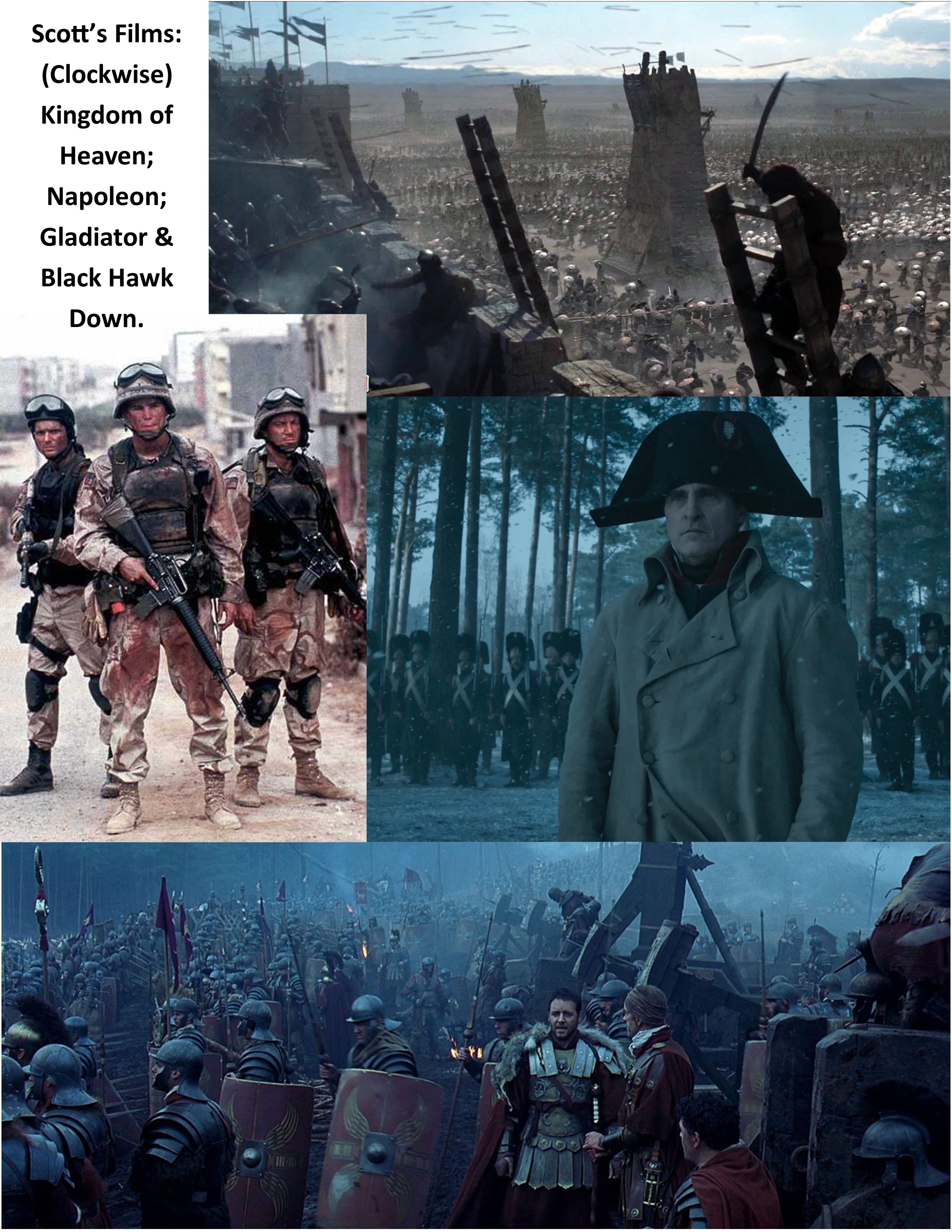
* MHT’s Top 10 film set piece battles: The previous mentioned Gladiator – Roman Legions vs the Gothic Tribes & Black Hawk Down - Mogadishu Rescue; Saving Private Ryan - Omaha Beach D-Day; Braveheart - Battle of Stirling; 13 Hours: The Secret Soldiers of Benghazi - as special force operators defend a covert CIA compound; Apocalypse Now - LTC Kilgore's U.S. Army 1st Squadron/9th Air Cavalry Regiment/1st Cavalry Division attack with the fantastically moronic musical calling card "Ride of the Valkyries"; Zulu - the Battle of Rourke's Drift; The Last of the Mohicans - ambush of the British column; Cross of Iron – Director Peckinpah's WWII German rearguard action versus the Russian T-34s; & finally Gettysburg - the legendary Pickett's Charge.

Having studied Napoleon’s work since arriving at the U.S. Naval Academy & purchasing what I consider the Corsican’s historic bible, Chandler, D. (1973) “The Campaigns of Napoleon – The Mind & Method of History’s Greatest Soldier” Charles Scribner’s Sons. It is 1172 pages of masterful analysis of the Napoleonic art of war. I expected this film to much like the movie “Oppenheimer” that used an informative book in that case, American Prometheus: The Triumph & Tragedy of J. Robert Oppenheimer to be the inspiration for this movie.
I went to MHT’s Napoleonic War expert for his opinion: “As a student, & instructor of military history, & a military historian who has studied his battles & campaigns (inside & out) since I was eight years old, starting from the 1790's at Toulon, France, to the final "Hundred Days" campaign in Belgium in 1815 & I've walked the very battlefields he fought at (i.e. Austerlitz, Château-Thierry, Waterloo, etc.) so I know a thing or two when it comes to him.
So, here's my take on the new film, Napoleon (2023.) This so called "film" (or whatever it is that you want to call it) is nothing more than one long historically inaccurate "Snooze Fest" that could put even a diehard insomniac to sleep within the first twenty minutes into watching, it's that BORING! The battles that were chosen to represent where he fought (i.e. The Battle of the Pyramids (Egypt), Austerlitz (Czech Republic), Borodino (Russia), and Waterloo (Belgium) are NOT historically accurate as they should be (and I expected A LOT more on that end of things!) I have taught Napoleonic Warfare at Building Four at Ft. Benning, GA [Editor’s Note: Now the Maneuver Center for Excellence where the U.S. Army Infantry School & Armor School were combined. Fort Benning named for a Confederate Brigadier General was changed to Fort Moore for LTG Harold "Hal" G. Moore Jr. USA(Ret) & his wife Julia "Julie" Moore famed for the book "We Were Soldiers Once and Young" authored with Joe Galloway & Mel Gibson’s 2002 film “We Were Soldiers.”]
Good things about the film:
1) The complicated relationship between Napoleon & Joséphine was okay, however it was historically inaccurate. (Joséphine was older, six years older than Napoleon)
2) The cinematography for this film was good [Ed. Note: Darius Wolski started in music videos from 1989 Aerosmith: Janie’s Got a Gun through 2015’s The Martian]

3) The uniforms & equipment were spot on, especially for those representing the French Foot Grenadiers (1er Grenadiers-à-Pied de la Garde*) of Napoleon's "Old Guard". [Ed. Note: The 1st Foot Grenadier Regiment of the Imperial Guard is an elite regiment of the Grande Armée during the Napoleonic Wars. It was the oldest infantry regiment of the Grande Armée. They are immediately recognizable for their emblematic headgear, the large black bear fur cap, decorated on the front with a brass or bronze plaque decorated with Napoleon’s imperial eagle.]
Bad things about it:
1) I'll say this again, Joaquin Phoenix doesn't even come close to resembling Napoleon Bonaparte. (I don't know what the hell Ridley Scott was thinking when he cast him for this role because it doesn't work.) Rod Steiger did a helluva better job portraying Napoleon in the 1970 film, “Waterloo” than Phoenix did.
2) There was no in-depth historical research conducted in depicting the battles where Napoleon fought in this film & it shows (I'm still thoroughly incensed about the scarcity of historic accuracy.)
3) This film should've started with his birth on Corsica in 1769 and depicted his early years growing up, him joining the army, his development as a highly intellectual tactician/commander in the field, as emperor, his death on St. Helena, and finally his burial at Les Invalides in Paris, France in 1840.
I should've just stayed home, saved my money, waited for it online & watched the far more superior 1970 film, Waterloo instead of this stinking pile of movie manure.
Overall rating for this monstrosity, D-.”
SSG Steven C. Girard, USA Ret.
Archivist/Historian/Researcher 4th Brigade (Marine) & 2nd Division, AEF, 1917-1919.
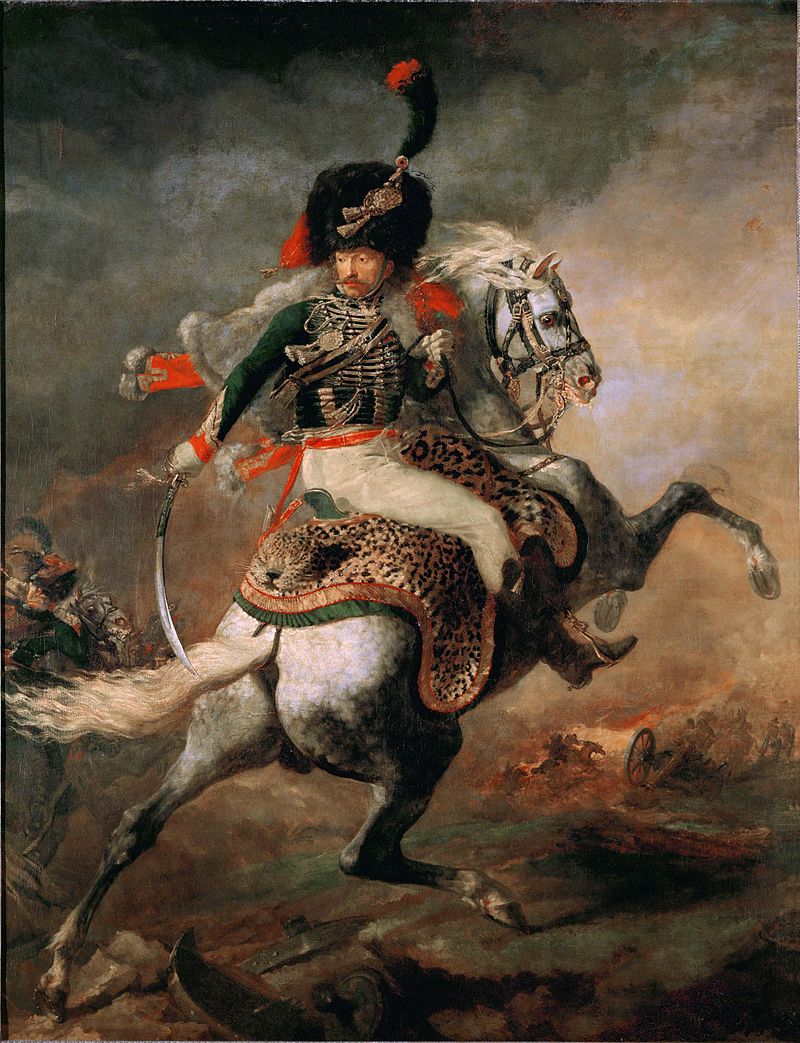
This is what I wanted: Charging Chasseur, or An Officer of the Imperial Horse Guards Charging, is an oil painting from 1812 on canvas by the French painter Théodore Géricault, portraying a mounted Napoleonic cavalry officer who is ready to attack.
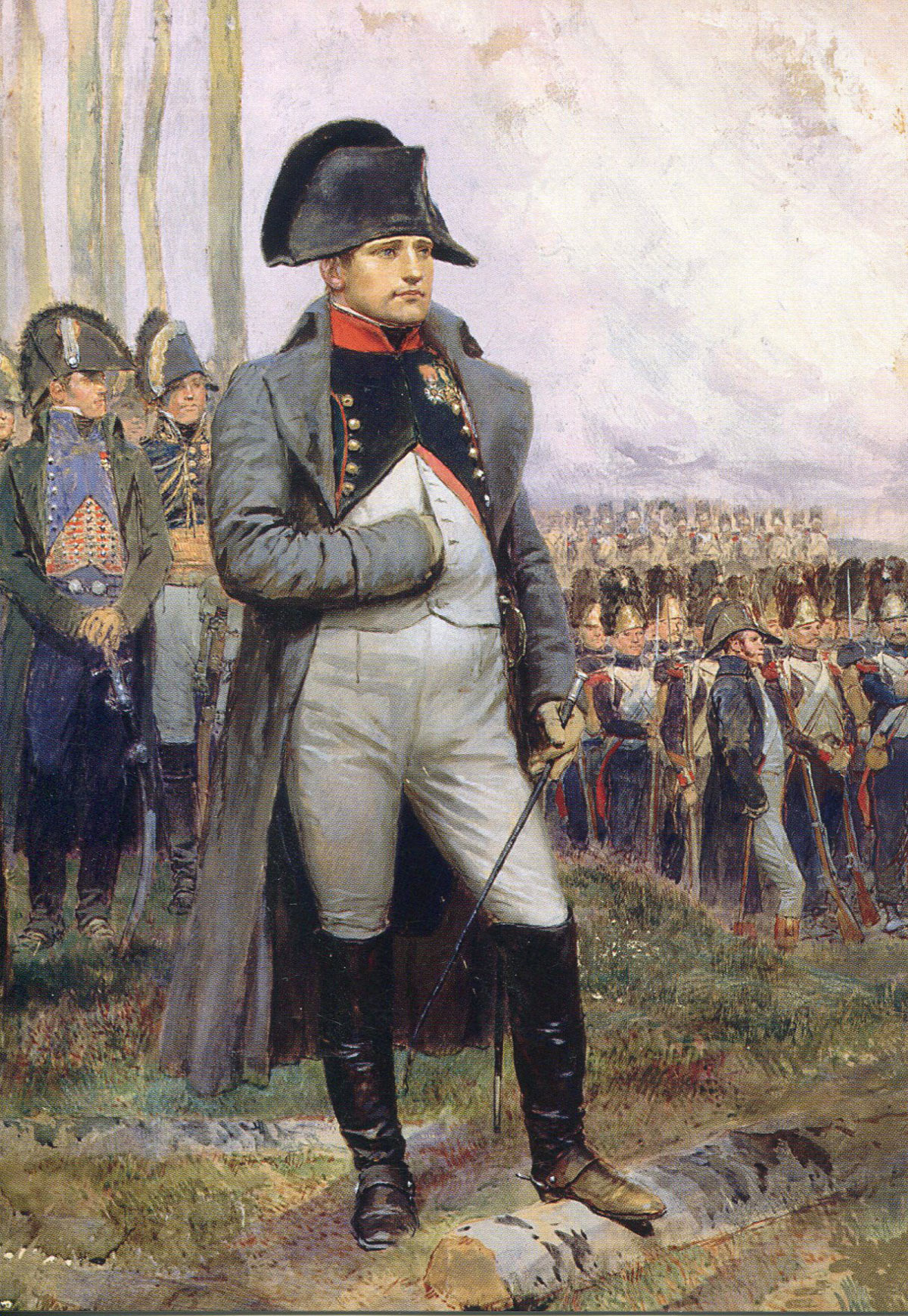
I wanted Scott’s film to showcase the military genius who conquered Europe & whose war-fighting skills bred some of these warriors: Nathan Bedford Forrest: Perhaps the greatest natural military tactician of all the Civil War commanders; Robert E. Lee: An American military icon. Until his defeat at Gettysburg (1863), his operational brilliance gave the Confederacy its greatest chance for Civil War victory; Ulysses S. Grant: Western victories, especially Vicksburg (1863), made him Lincoln’s General to finally defeat Lee’s Army of Northern Virginia; Helmuth von Moltke: As chief of the General Staff (1857-88), Moltke engineered Prussia’s victories over Denmark (1864), Austria (1866) & France (1870) – triumphs that led to Prussia’s leadership of the new German Empire; Thomas J. “Stonewall” Jackson: Jackson was Lee’s most brilliant subordinate. His friendly fire death after his stunning victory at Chancellorsville (1863) was Lee’s greatest loss & doomed the Confederacy. William T. Sherman: Often cited as one of history’s first “modern” generals, Sherman inflicted “total war” on the South in his Atlanta Campaign (1864) & subsequent March to the Sea. I expected a faithful character portrait of Napoleon & historically accurate large-scale recreation of his greatest victories like Toulon, Austerlitz & even his defeat at Waterloo.
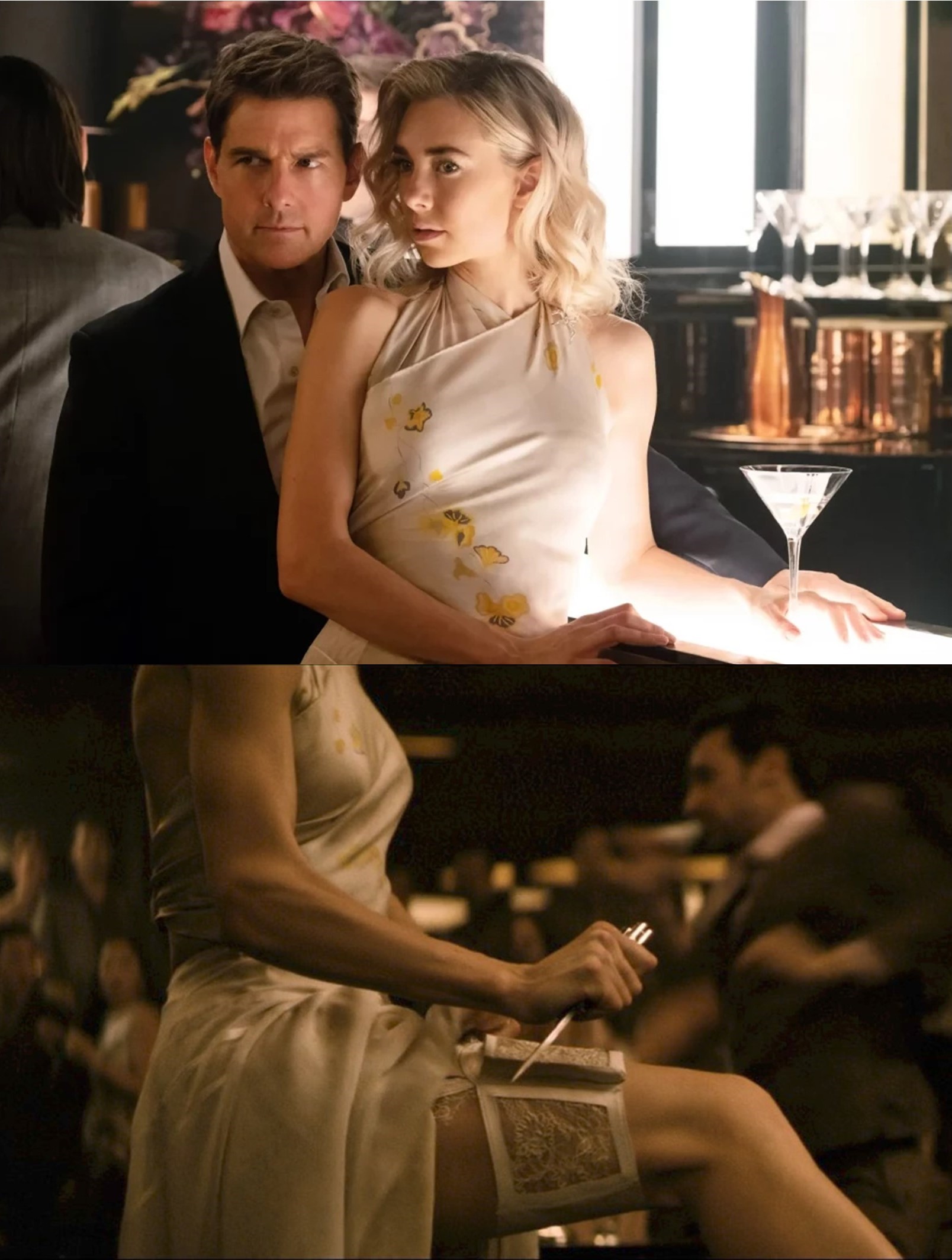
To my utter dismay, the film turned out to be a cringeworthy & bloated costume romance: a highly fictionalized love story between Napoleon and his wife Josephine, who was a mere footnote in the General’s illustrious life and career, with most details available about her being from fictional accounts & documents. The 20-year difference between the two leads was far too obvious (Vanessa Kirby 14 years younger than Joaquin Phoenix when she should have been six-years older) She is English & probably recognizable from TV’s “The Crown” or the big screen’s action franchise “Fast & Furious 9” as Hattie & in both of the last two Tom Cruise “Mission Impossible” movies playing the White Widow pushing her to the front of the class of action movie heroines & femme fatales.

Like a Lifetime movie so much time & attention was paid to the relationship between Napoleon & Josephine that it forgets everything else that made Napoleon the man we remember him for (Lifetime synopsis: Small-island man goes to the big city where he falls for a cunning stylish socialite & is forced to attack all of Europe in “An Empress to Kill For.”) The film makes the case that Napoleon did great things & conquered the continent because all he wanted to do was impress Josephine. In the biggest howler scene, Scott has Napoleon confess to Josephine that he was nothing without her. Sadly, I haven’t read what would account for the kind of reverence that the film’s writer Scarpa purports Napoleon has for Josephine. Some wag said the two leads chemistry is as leaky as the Wu Han Lab. Even if their chemistry had felt real, the film would have had something else to offer…comedy. The efforts at comedy, which I don’t understand why these weak efforts at humor were needed as they broke up the narrative flow. [I can’t wait for Spielberg to pick-up on this material-lightening requirement & recut “Schindler’s List” to lessen the dark mood with Ben Kingsley cracking some jokes about showers…hey maybe the former Harvard President could write them as she has some time now (or would she just steal some Seinfeld or Larry David material…”Hey Nazis don’t take showers; they only take blood baths. Bada-Bing”] - Sarcasm Font! If I wanted comedy I’d watch “Bill & Ted’s Excellent Adventure” to see Terry Camilleri improvising as he has some of the funniest moments as Bonaparte transported to 1989.
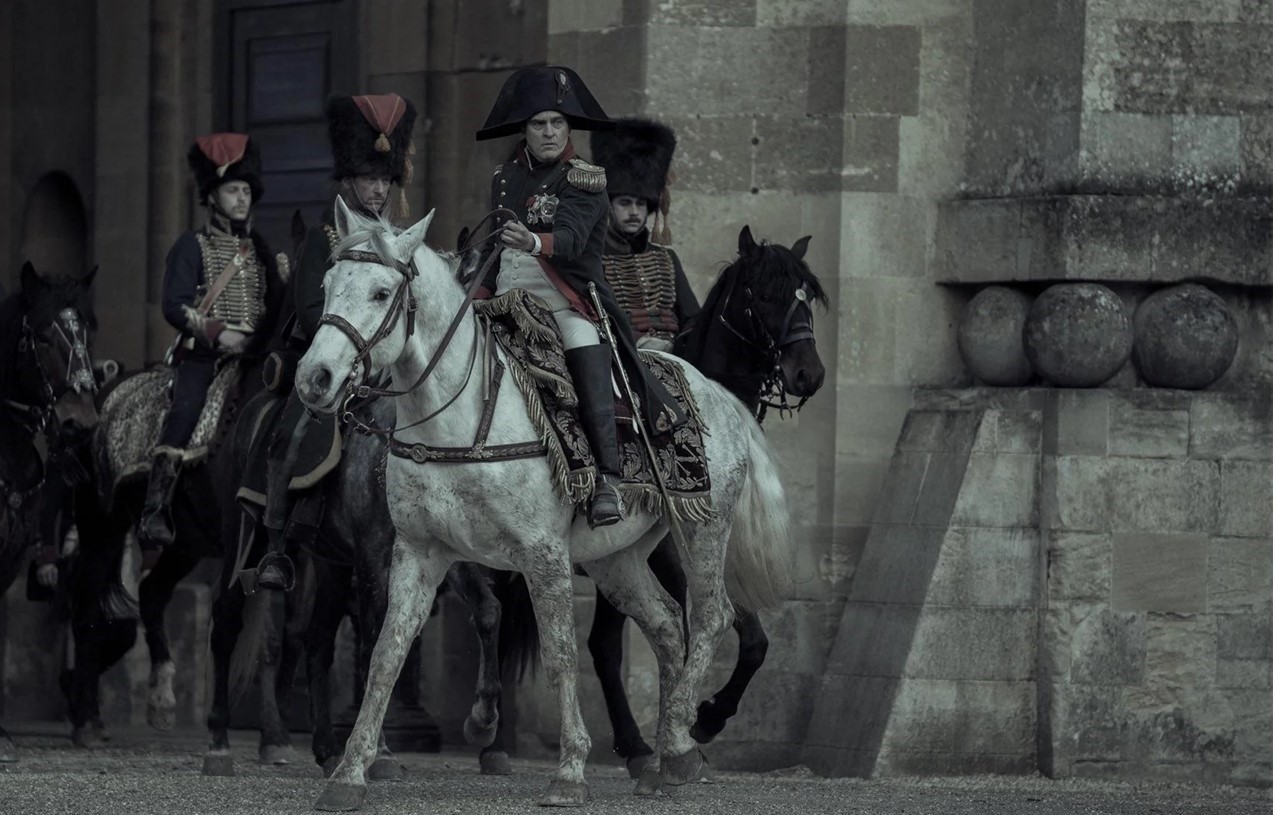
I have to say that Joaquin Phoenix’s interpretation of this iconic historic figure was just devastatingly underwhelming. Phoenix cannot be held accountable as the poor writing undermined his performance onscreen. Napoleon was known for his fiery speeches & his ability to lift his soldier’s morale rallying them to battlefield feats of glory
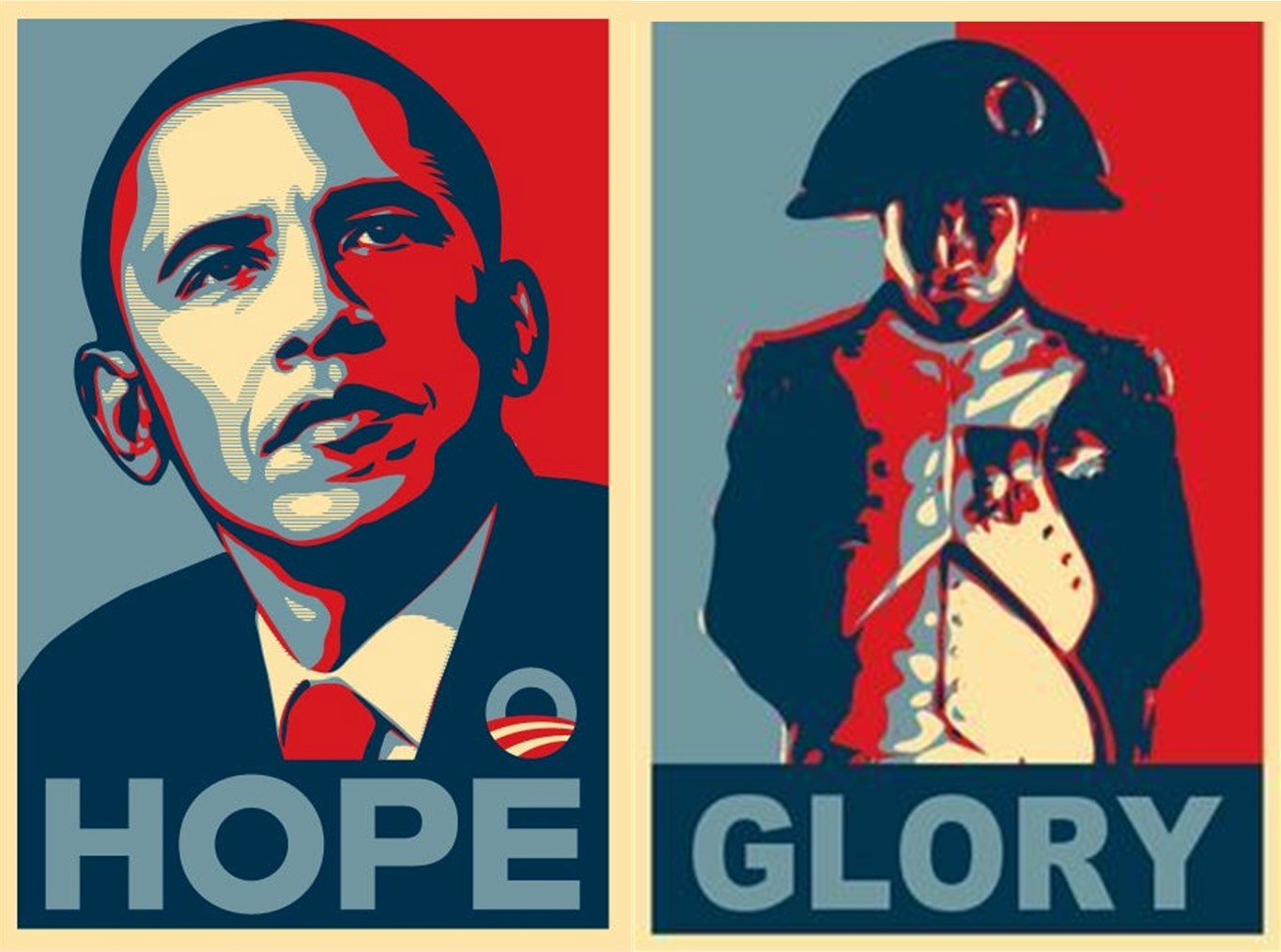
[The funny meme shows the stark contrast between Hope that often results in failure & leadership that can attain Glory] Why wasn’t the film laced with memorable dialogues & numerous quotes that would be rousing and inspiring. The script does nothing to make him the larger-than-life character that he was. There is a dearth of great leadership speeches but instead we get the General making love with his wife under the dining room table in the full view of his palace guards. Phoenix can’t overcome a one-dimensional, poorly-written & almost incomplete character to play. Maybe heroes are too much as he can only master the bad boys see “Walk the Line,” “The Joker” & Scott gets a pitch perfect performance from Phoenix as Commodus in “Gladiator.”
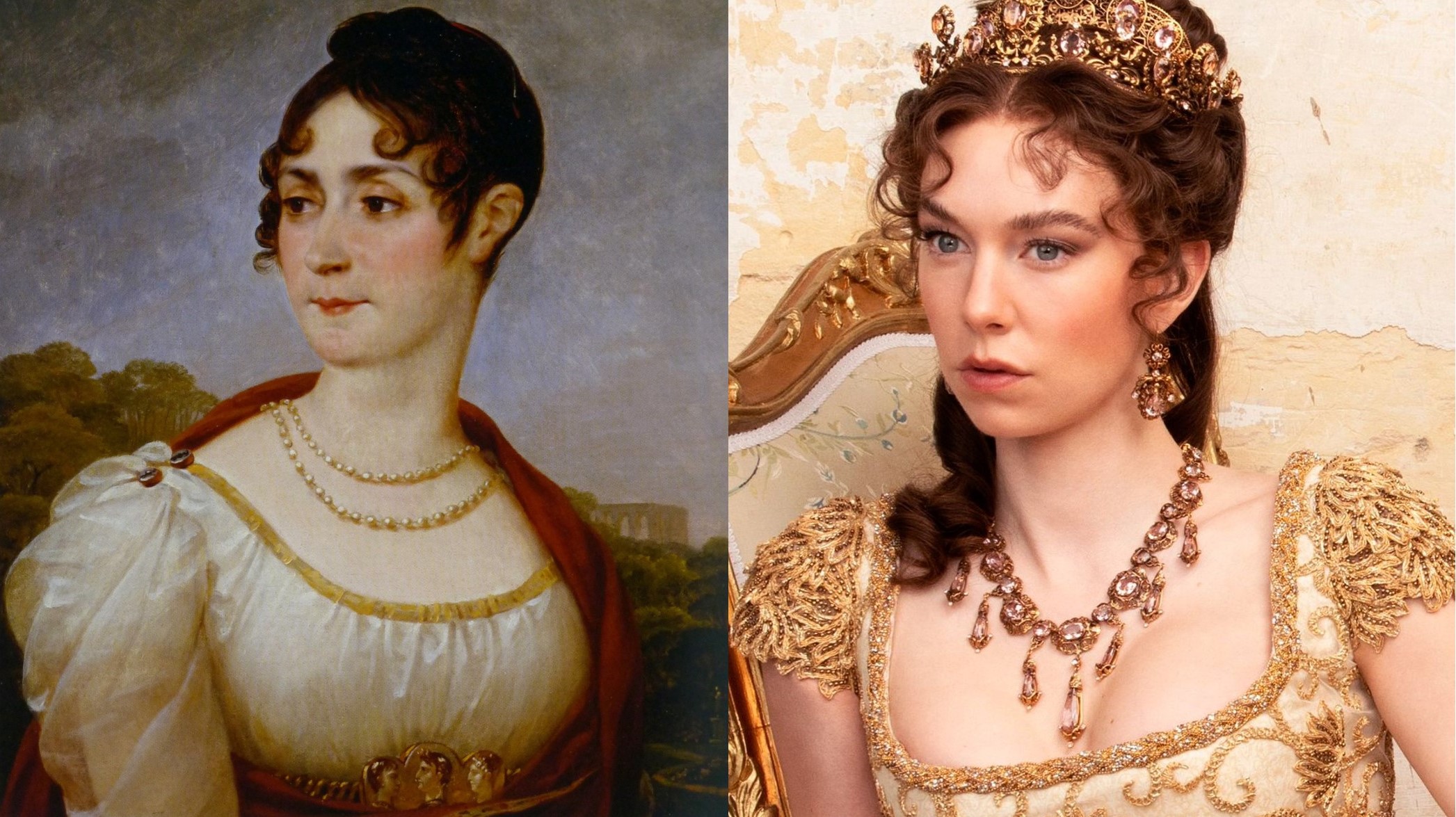
Vanessa Kirby as Josephine is often the films prime focus but also suffers from the same lack of script support as the lead character. We never get the feeling of the hurt & torture that both the lead characters must be feeling over their inability to produce an heir. While the director plays out this portion extensively, I felt nothing for either character. Maybe the editing is to blame as the transitions are herky-jerky & all we can hope is the 4-hour Director’s Cut will take the cutting room floor clips to flesh out the politics & give us the clarity of the battle’s generalship.

Although she is often referred to as "Joséphine de Beauharnais," it wasn’t the name she used. "Beauharnais" is the name of her first husband who went under the guillotine during “The Reign of Terror.” Upon her marriage to Napoleon, she adopted the last name "Bonaparte." The name "Joséphine" was also from Napoleon, who tossed aside the name Rose she used before meeting him (most likely created from her middle name, Josèphe.) The misnomer "Joséphine de Beauharnais" emerged during the restoration of the royal House of Bourbon, who were hesitant to refer to her by either Napoleon's surname or her imperial title.
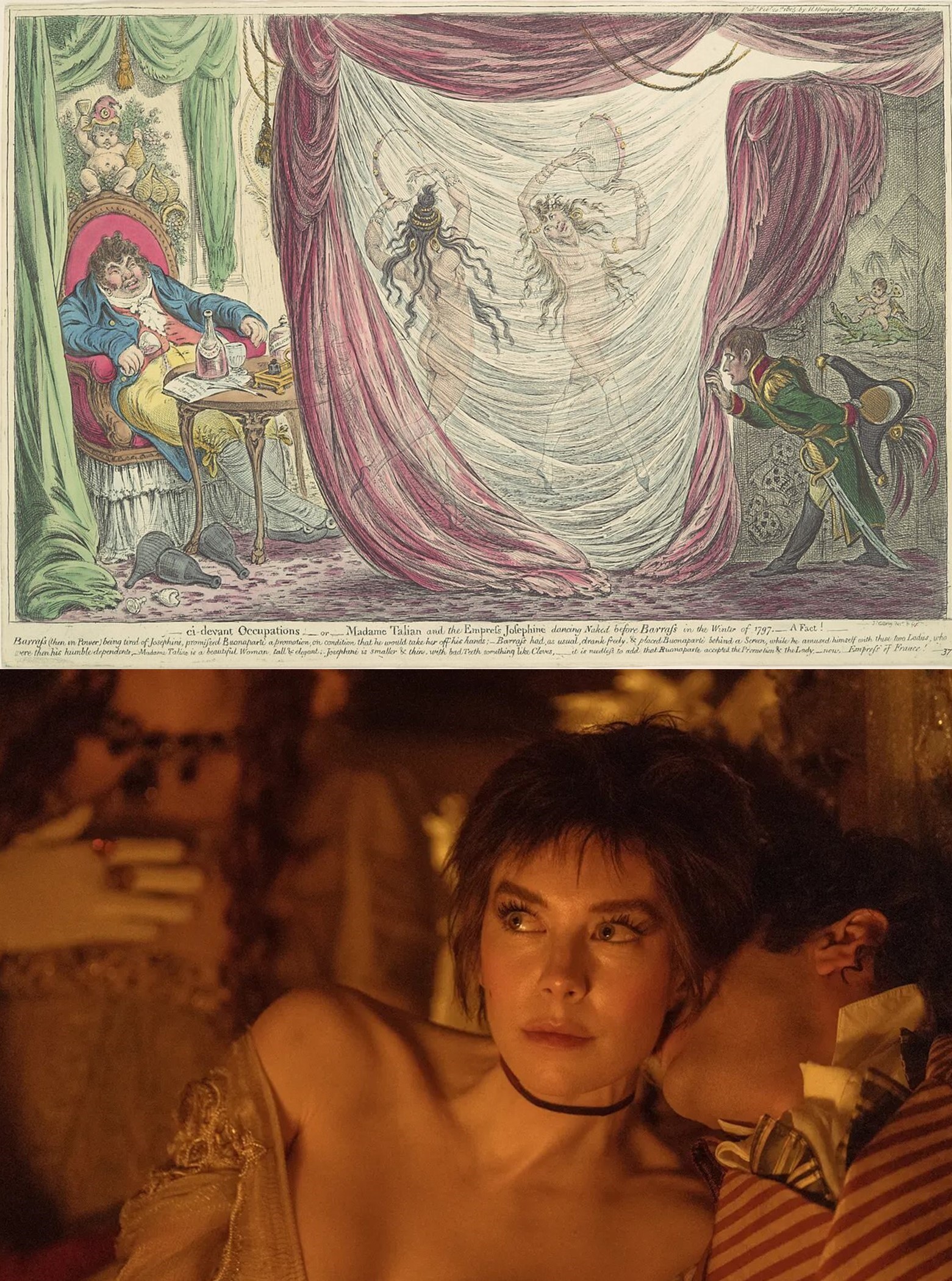
Paul Barras one of the political leaders of The Convention (French Revolutionary Government) used young General Napoleon’s artillery expertise to disperse a royalist & National Guard attack on Paris. Bonaparte used a “Whiff of Grapeshot” from his massed cannons to defeat a far larger force & rose in Barras & the new government’s eyes. Even more powerful as a Director, Barras who had dozens of mistresses both male & female, took up with two women who had become friends while imprisoned by Robespierre in Les Carmes Prison during “The Terror.” One was Teresa Tallien, one of the most beautiful women in Paris who would survive to become one of the leading socialites of Revolutionary Paris. “But while her beauty provided her with important erotic capital, in some ways, it obscures the intelligence allowing her to make use of that asset, as well as the political role that she played. Both contemporaries and later biographers were so fixated on her physical appearance and sordid reputation (she was divorced twice, married three times, public mistress of two famous men, and mother of ten children, five fathered by her lovers) that her role as a political actor sometimes appears as an afterthought.” *
*Adams, Christine "Mistresses and Merveilleuses: The Historiographical Record on Female Political Players of the Seventeenth and Eighteenth Centuries.” (2016): pgs. 101-2.
The other was Rose (Joséphine) de Beauharnais. It was rumored Barras orchestrated both the romance of de Beauharnais & Napoleon to get her off his hands & Tallien to millionaire G-J Ouvrard in a business deal because he could no longer afford her expenses. The rumor was used by the British press & James Gillray (the father of the political cartoons) to lampoon the French Emperor & Empress in London. Even today First Ladies still have to take the barbs of cartoonist well at least through Melania before current media censorship.
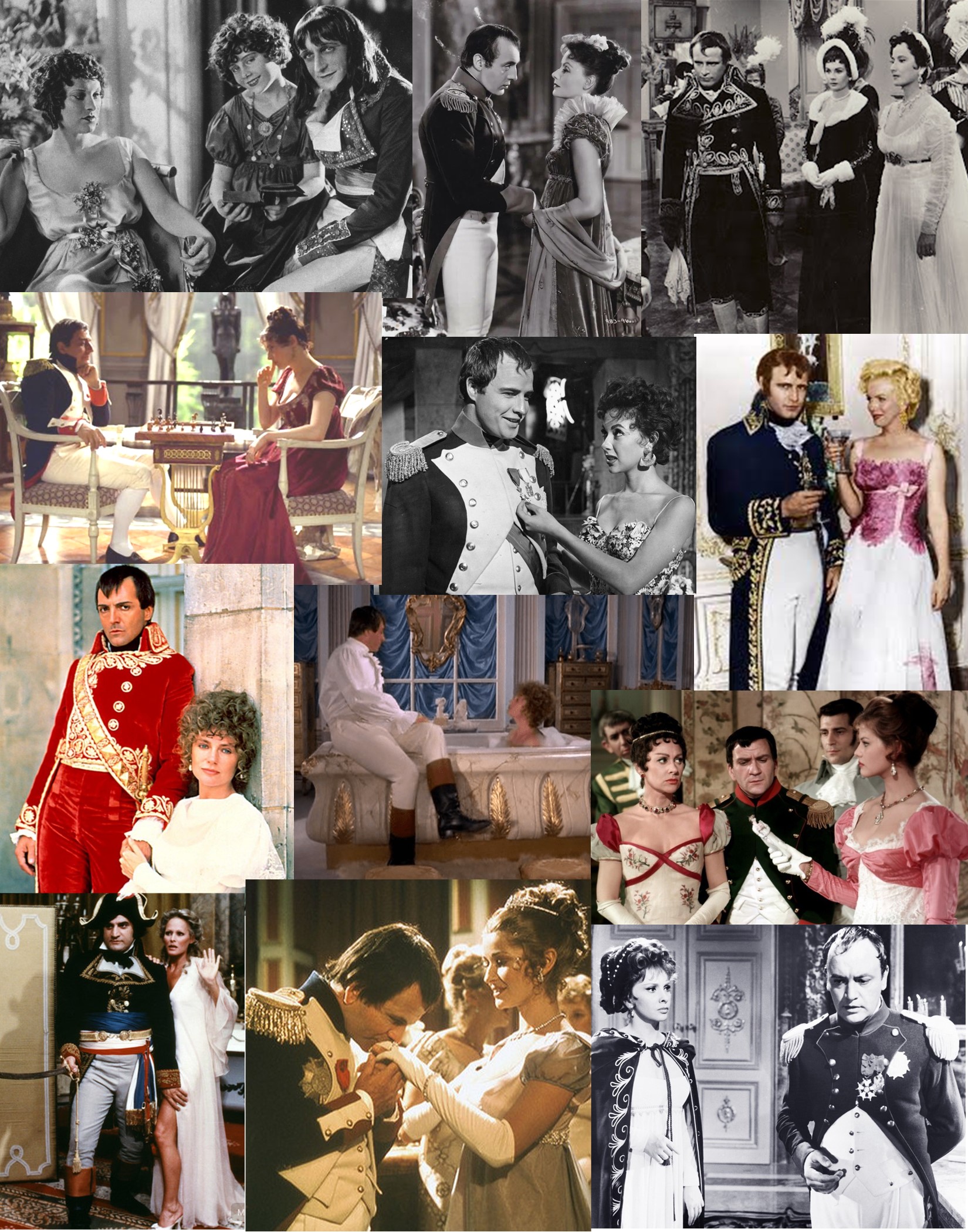
To investigate why this film is so enraptured with the “Cult of Josephine” let’s look at the films that may have influenced this Harlequin Romance movie (see each film clockwise above):
Napoleon (1927) - Director Abel Gance’s introduced a three-projector widescreen precursor to Cinerama in this silent classic that first brings the Napoleon & Josephine romance to the silver screen
Conquest (1937) - Charles Boyer plays the emperor while Greta Garbo is a sultry Josephine
Désirée (1954) - starring Marlon Brando in a romance with Désirée Clary (Jean Simmons) that is all romance-no battles with multiple Brando lovers showing up on set, a 22-year-old Rita Moreno & 28-year-old Marilyn Monroe (thankfully on different days - see uniforms)
The Battle of Austerlitz (1960) - Abel Gance does a "talkie" 33 years later with Pierre Mondy as Bonaparte with Claudia Cardinale as sister Pauline with the battle & many bodices
Imperial Venus (1963) - Napoleon's sister Pauline gets another sultry Italian actress with Gina Lollobrigida in the role
Napoleon & Love (1974) - a nine-episode TV series that takes an inside look at Napoleon’s (Ian Holm) love life with Stephanie Beacham as one of the mistresses highlighted
The Loves & Times of Scaramouche (1976) - a comic Aldo Maccione as Napoleon stumbles on Ursula Andress as Josephine bathing in a pond
Napoleon & Josephine: A Love Story (1987) - a three-part TV mini-series starring Armand Assante as Napoleon & Jacqueline Bisset as Josephine with a crazy perm in the bath
Napoléon (2002) - Christian Clavier is a tepid Emperor in an international TV mini-series, he was far better as, Jean Reno's medieval Duke’s riotous squire in "Just Visiting" however Isabella Rossellini makes an elegant & glamourous Empress

Above the oldest Napoleon film is from 1927 & was a 6-hour epic about the rise of Napoleon from a boy in Corsica to General of the French Army in Italy. Director Gance was a master innovator, introducing fast scene cutting, extreme close-ups, a wide variety of hand-held camera shots, shooting on location, point of view shots, multiple-camera setups, multiple exposure, superimposition, underwater cameras, kaleidoscopic images, film tinting, split screen & mosaic shots, & the revolutionary multi-screen projection as he hoped to make five more in the series. I was surprised by his scenes of the eruption of gaiety following the “Reign of Terror’s” end, Galas were held for the survivors & one Victim's Ball was held at Les Carmes Prison. The Ball honors Napoleon for his putting down the Royalist uprising with the “Whiff of Grapeshot” plus three Parisian beauties chosen to be exalted who were formerly imprisoned there. This being a French film & pre-code (before censorship & movie ratings) three scantily attired beauties Thérésa Tallien, Madame Juliette Récamier & Joséphine are introduced to the crowd. Napoleon is fascinated with Josephine & he beats another admirer at chess as she watches & who then entices Napoleon with her charms & fan. Frenchman Gance films a delirious vision of debauchery including female guests becoming more uninhibited in increasingly provocative gowns. The night ends with frenzied dancing with bared breasts & an exposed derriere or two, that is probably more about the Roaring Twenties excesses after the Great War then 1796 Paris plus giving the movie’s release some naughty hype.
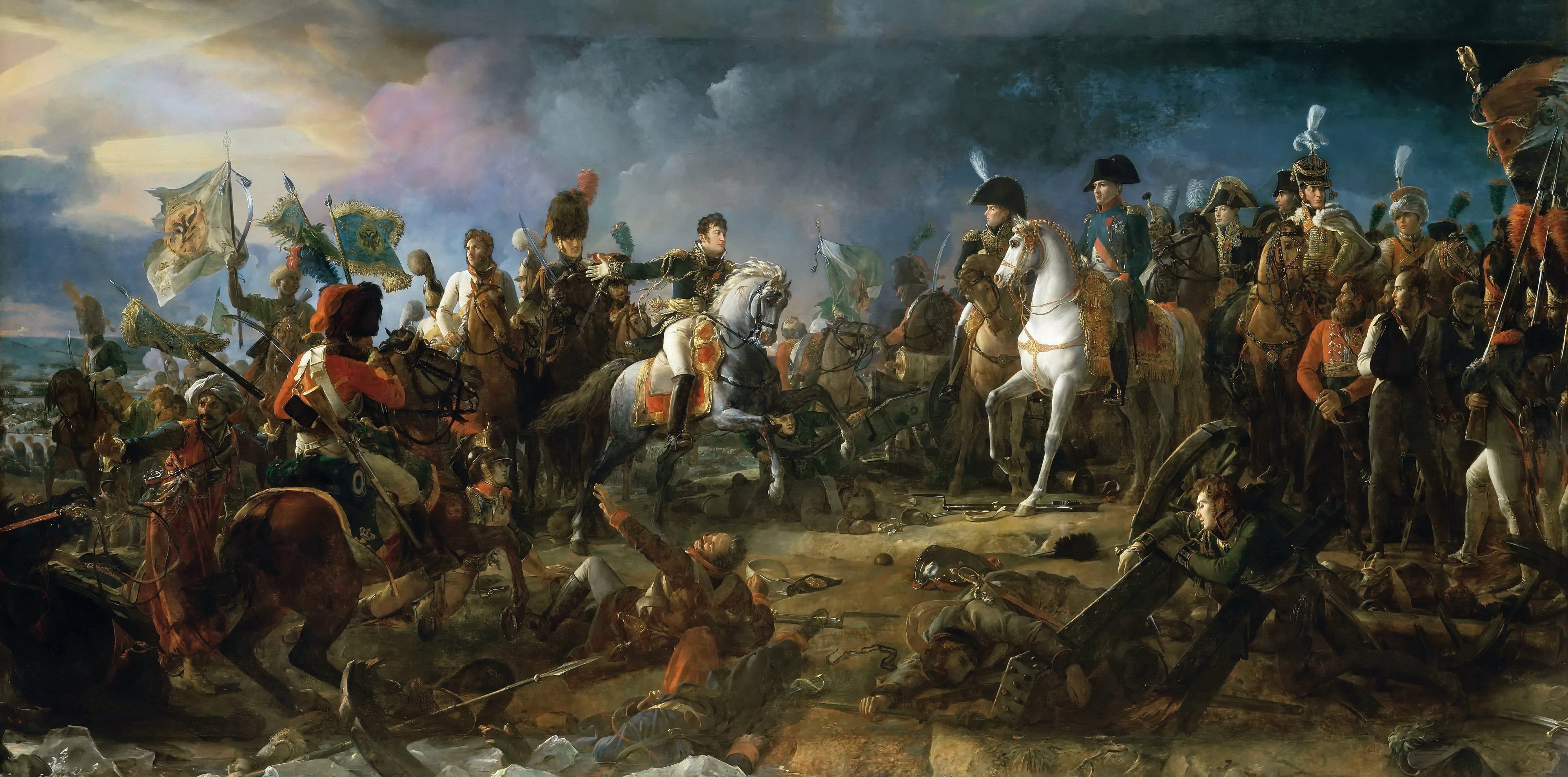
Director Scott, had planned his filming of the Battle of Austerlitz to last six days but he noted, “we did it in three & a half.” One key to the director’s efficiency was that he shot with multiple cameras simultaneously for the filming of Napoleon, he usually used four but sometimes as many as 11. He requires fewer takes & far less time for a reshoot. “In the morning, I’ll tell my brilliant cinematographer, Dariusz Wolski, ‘I want a camera there & there & there & there. How long to set them up?’ He’ll say, ‘40 minutes,’ and I’m shooting by 9 AM,” Scott says. “Other directors use one camera & they go on forever, but this literally allows me to shoot 4-to-11 times faster.”

The Battle of Austerlitz involved upwards of 68,000 French troops & 90,000 Austro-Russians, however you can’t get such massive number of extras for a film. Scott admitted “You can’t really do more than 600-foot soldiers in a day. They have to come in at 4 AM to be ready by nine, and that’s with 200 people working as dressers.” For his battle scenes, 400 human soldiers & 100 horses were positioned on the front lines, with CGI [special effects] used to expand their ranks behind them.

“The extras were great,” says Scott. In Napoleon, what passes for Austerlitz is actually a digital composite of two locations. The wooded hill that serves as Napoleon’s command post is a site in Bourne Woods near Surrey, England, which Scott had used previously in 2000 to film Gladiator’s Romans versus Germanic Goths battle. The frozen lake where most of the [Austerlitz] fighting takes place isn’t a lake at all. “That was actually Abingdon Airfield, just off the M4 motorway out of London,” [It was also used for the WWII “Masters of the Air” mini-series of the USAAF 8th Air Force.] says Scott. “The last thing you’d want to do is go on an actual lake and do the [stuff] that we did. That’s how you get in real trouble.”
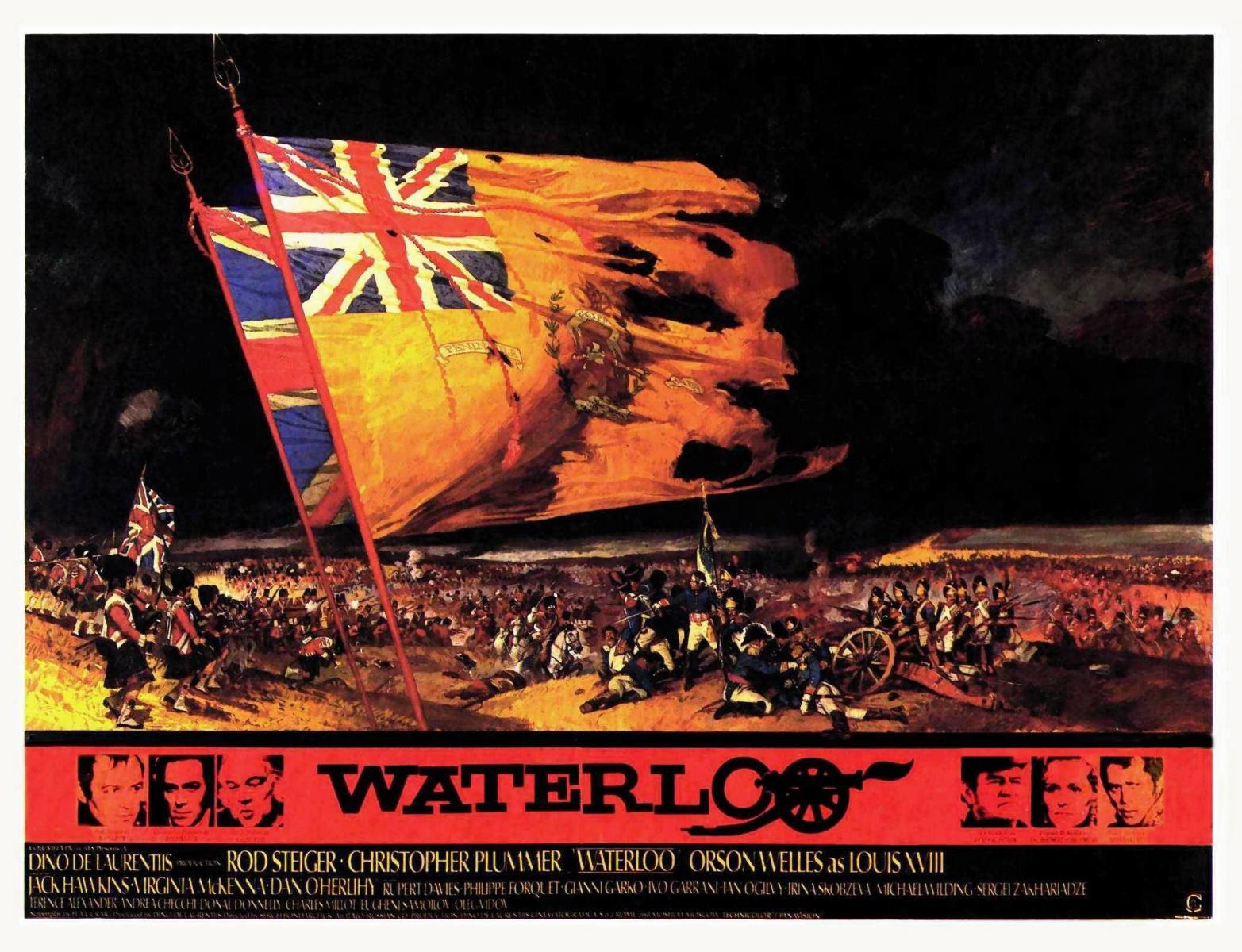
My SME (Subject Matter Expert) Steve told me in the strongest terms, that if I was doing a blog post on Waterloo, then he HIGHLY recommended doing it on the 1970 film, “Waterloo” with Rod Steiger as Napoleon & Christopher Plummer as the Duke of Wellington (compared to Rupert Everett vs Phoenix in the newer film). Italian Producer Dino De Laurentiis brought Napoleon to the screen in a very faithful account of his final battle. The movie tanked at the box office, but is a particular favorite among history buffs and armchair generals. Rod Steiger is renowned for capturing his mercurial genius & dynamic leadership style balanced by monstrous ego & self-indulgent entitlement, all cloaked in flashes of pathos as he knows his time as Emperor is running out.
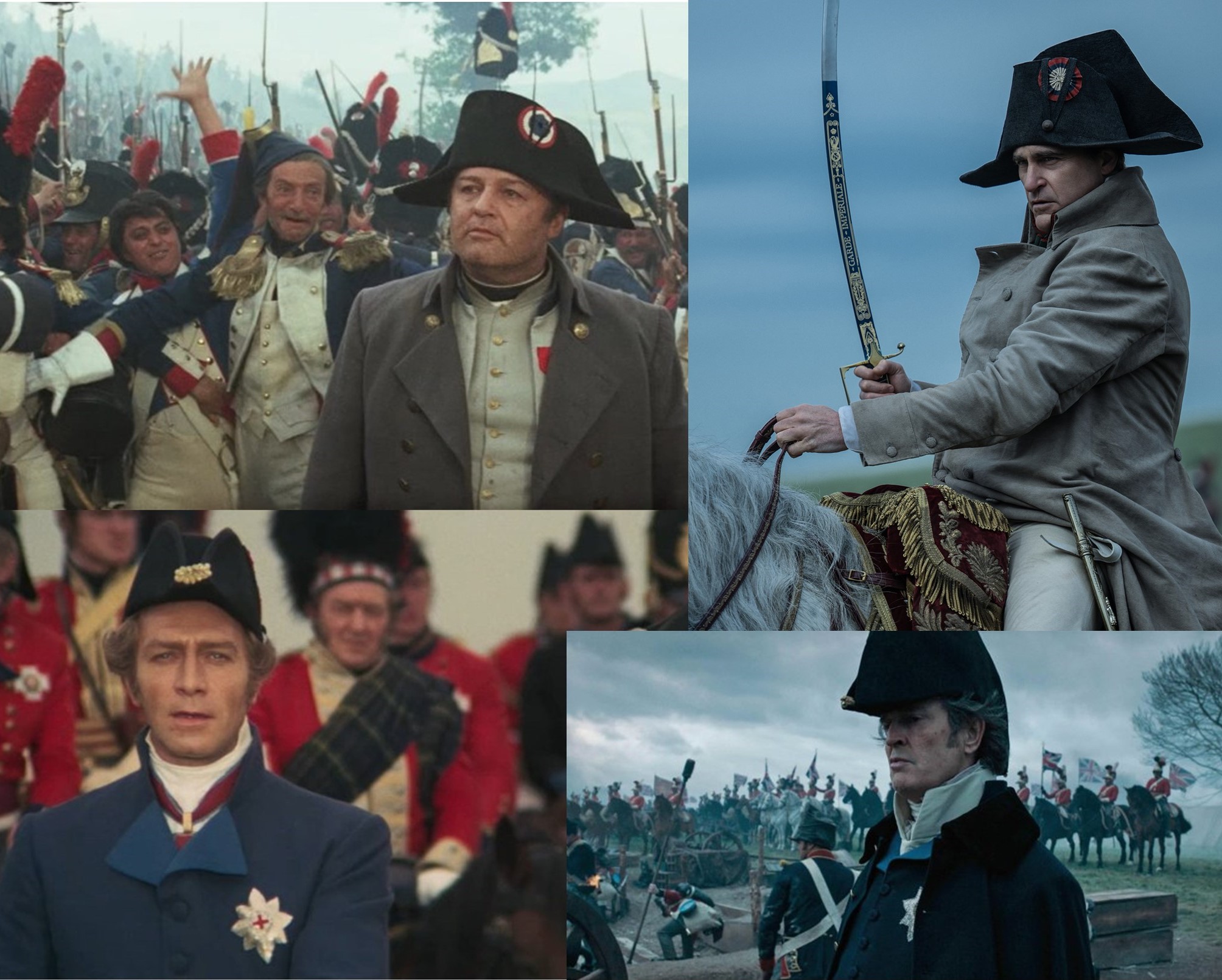
“Waterloo” was one of several co-productions between Italy & Russia around this time. Producer De Laurentiis had difficulty finding financial backers for this massive undertaking. He began talks with the Soviets in the late 1960s finally reaching an agreement with Russian state-run studio Mosfilm. The final costs were about U.S. $38.3 million in 1970 dollars making it the most expensive movies for its time, which in 2024 dollars would make it #10 behind only the huge CGI comic book-science fiction blockbusters of the last 10 years. Filming took place in Rome & Ukraine SSR (then still part of the USSR) throughout 1969 & would have cost three times as much if filmed in the West. Mosfilm contributed 15,000 Soviet Army infantry soldiers, a full brigade of 2,000 Soviet cavalrymen as extras as well as 50 circus stunt riders to perform the dangerous horse falls plus a host of engineers & laborers to prepare the battlefield in the rolling farmland outside Uzhhorod, Ukrainian. [The Russians would love to have their soldiers in Uzhhorod today as the city is on the Slovakian border meaning they would have conquered all of Ukraine.] Months before the cameras started filming, the 17,000 soldiers began training to learn Napoleonic drill & battle formations, as well as the use of sabers, bayonets on the long muskets & handling bronze cannons. A selected 2,000 soldiers were also taught to load and fire actual black-powder muskets. This “movie” army lived in a large encampment next to the battlefield. Each day after breakfast, they marched to large-wardrobe-buildings, donned their French, British or Prussian uniforms & fifteen minutes later were in position.
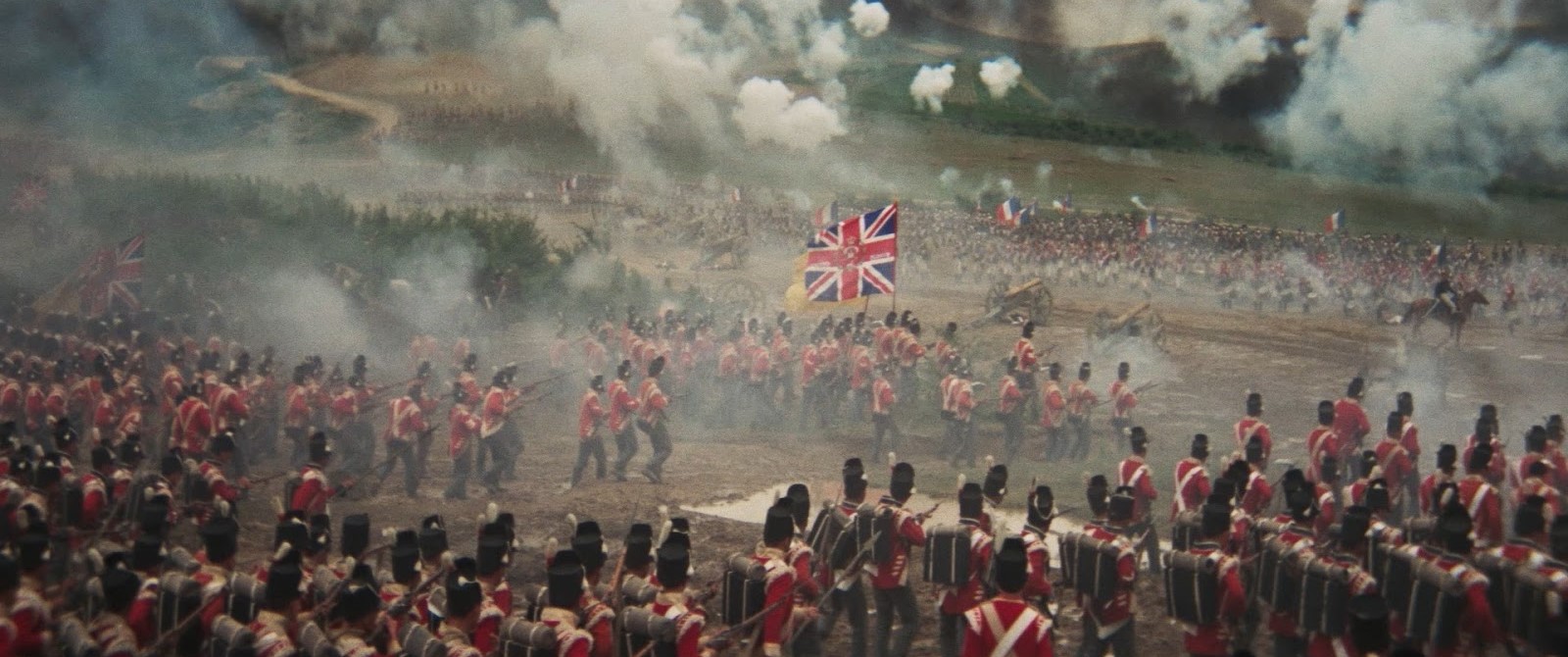
To recreate the Belgian battlefield "authentically," Soviet Army engineers used bulldozers to knock down two hills, build five miles of roads, transplant 5,000 trees, plant fields, build the camp for the troops, while also constructing four replica historic buildings. To create the battlefield mud, more than six miles of underground irrigation piping was specially laid. The battle scenes were filmed using five Panavision cameras simultaneously, from ground level, from 100-foot towers, from a helicopter, and from an overhead camera railway built above the battle locations. Costing $5 million to prepare, it was the largest battlefield ever used for a film.
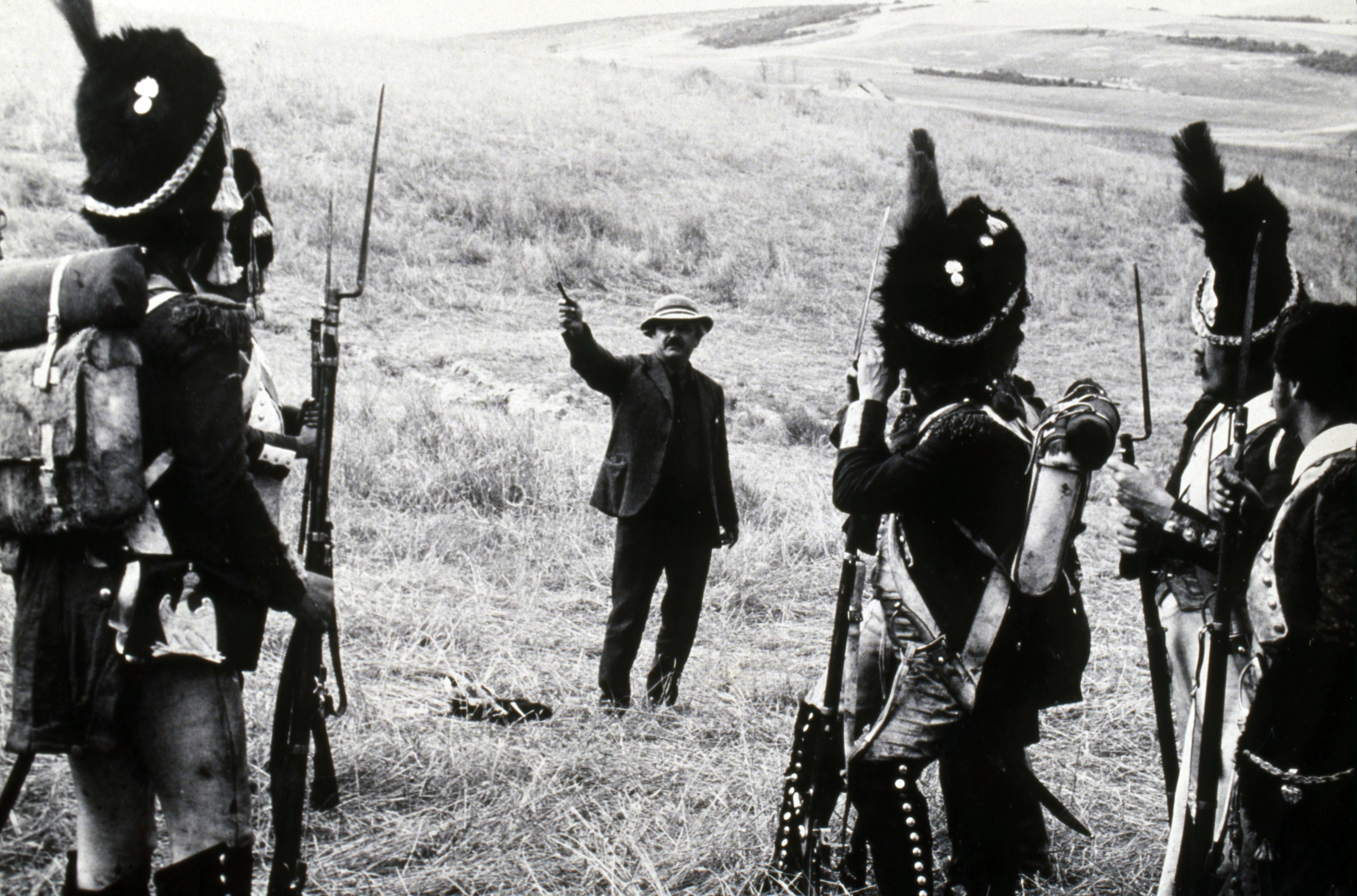
Mosfilm's involvement meant the movie would be directed by Russian Sergey Bondarchuk, who less than two years earlier had made an expensive large-scale version of “War and Peace.” Actual filming took over 28 weeks, which included 16 days of bad weather delays. The 17,000 soldiers were commanded by officers who took orders from Bondarchuk using walkie-talkies. To assist in communicating with all facets of filming this huge, multi-national undertaking, the director had four interpreters permanently at his side, one each for English, Italian, French & Serbo-Croatian. Besides the battle scenes in Ukraine, filming also took place on location in the Royal Palace of Caserta, Italy & the interior scenes were filmed in Rome on the large De Laurentiis Studios lot.
“Waterloo” gives us the sheer thrust of the artillery & the armies muscling into each other bringing the viewer a frontline sense of the action. The elements of the weather like the winds & rain are effectively integrated into the battle sequences to compound their effects on the battlefield. Despite the huge magnitude of extras & gear all this is done while still sticking to the details of the historical events & staying true to them. “Waterloo” has hands down some of the best cinematography ever displayed on a war film not relying on CGI. Director of Photography Armando Nannuzzi’s aerial shots showing the formations, tactics & combatants are breathtaking. He also gave the combat sequences a sense of speed by filming soldiers & the charging horses in a realistic manner. The pitch-perfect editing adds to the film’s overall authentic feel.
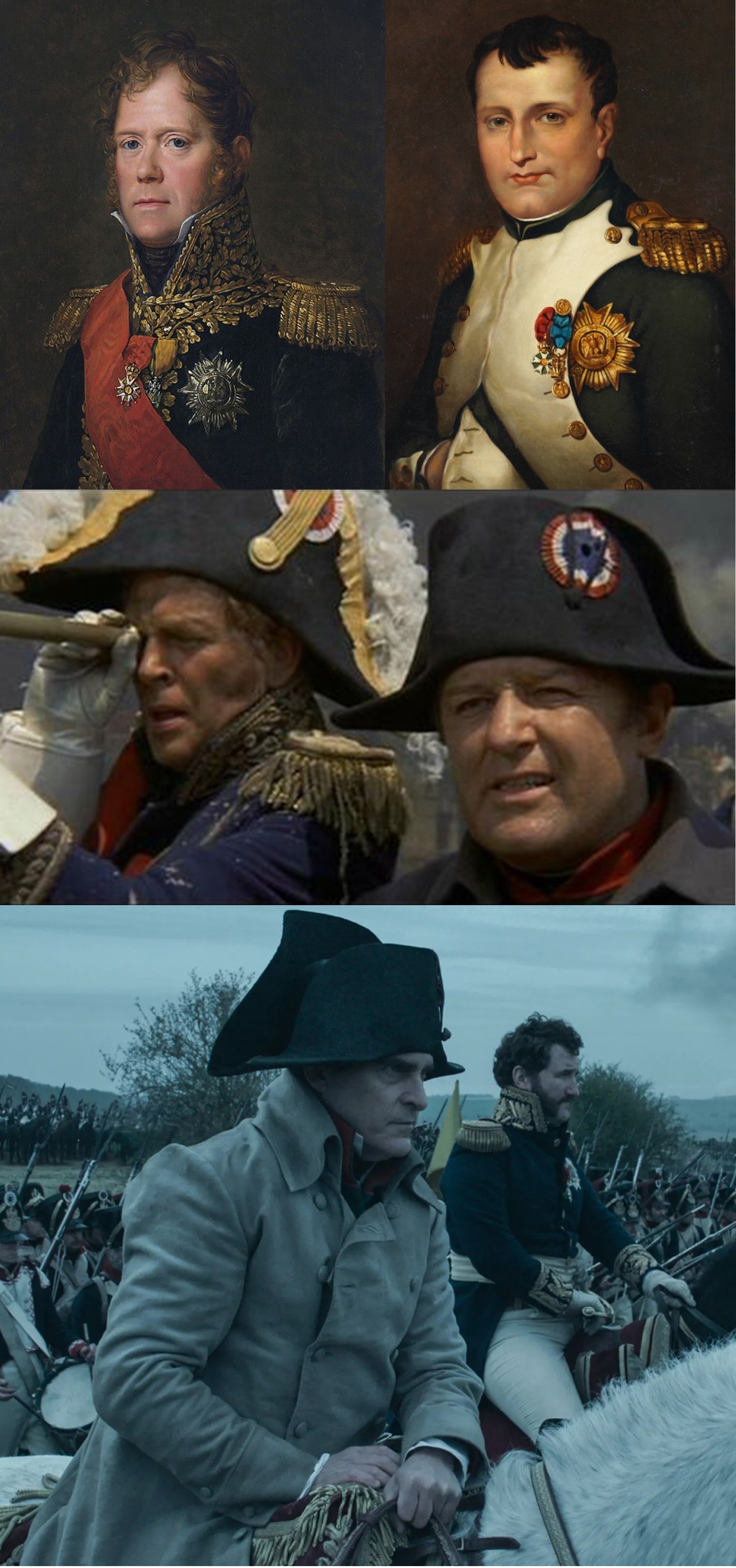
It presents many really great stories such a Marshall Michel Ney, by legend the last man of the Grande Armée to leave Russia, leading a detachment of the Army loyal to the reinstated King Louis XVIII to capture Napoleon who has escaped Elba & promises to bring him to Paris in a cage. However, Napoleon put it in the hands of Ney’s soldiers keeping his forever loyal Old Guard escort behind him. Both groups hail him their Emperor & the now united headed on to Paris chasing the Bourbon King back into exile.

He reunified the French army known since 1805 as the Grande Armée that for 10 years had allowed him to win so many notable victories & survive defeats which would have destroyed lesser armies. Napoleon’s enemies would famously say his generalship was worth 50,000 men in the field, but the simple truth is he wasn’t able to dominate Europe without his soldiers & this has fascinated historians & people ever since. After all, in terms of equipment, weapons, & battlefield tactics, there was little to distinguish the Grande Armée from the other four Imperial European armies in the early 1800s, but in battle after battle it won spectacular victories, often against numerically superior enemies. No single factor can account for these victories, which could be attributed to a combination of high morale, a truly egalitarian approach to promotion from the ranks, a radical army organization, and the inspired leadership of Napoleon & his Marshals, all of which combined to make the Grande Armée virtually unbeatable for the first few years of its existence.
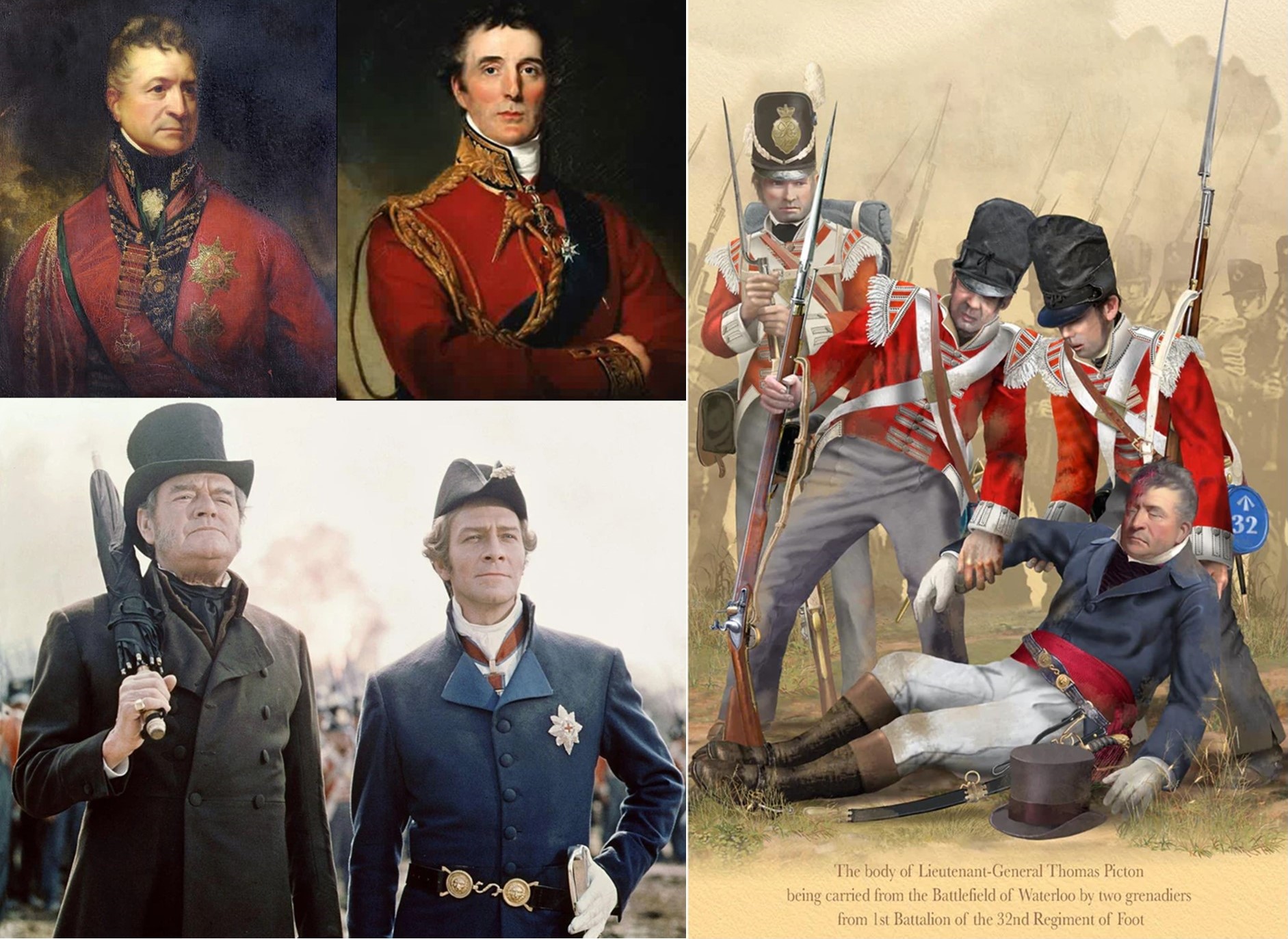
Another fascination story was that of Sir Thomas Picton who rose from an ensign to become a Lieutenant General in the British Army at Waterloo. Picton had a division in Spain that fought in several battles before he was wounded & returned to England to recuperate. He was Knighted after being thanked seven times by the British Parliament for his bravery fighting the French. In 1815, at the Duke of Wellington’s (played to perfection by Plummer) request, Picton commanded the 5th Infantry Division where he led them at Quatre Bras. Two days later during the Battle of Waterloo, Napoleon attacked the British Centre at Le Haye Sainte. General Picton who had been in the reserve lead his men in a bayonet charge against the French columns to stop the advance. He was shot dead through the temple. When his body was checked it was found he had been wounded in the hip two days before at the battle of Quatre Bras but had not told anyone other than his servant bandaging the wound himself. General Picton was the highest-ranking allied casualty at Waterloo.

“Waterloo” is 50% about the drama & the leader’s performances, the other half is about the war & how well it is filmed. When the men are being formed, one can see the sunlight glistening off their weapons. It is something that not even the greatest visual artist can envision & create a live version of “Scotland Forever!” This was an 1881 oil painting by famed artist Lady Butler about the charge of the Royal Scot Greys, a heavy dragoon regiment that in 1768 began wearing the tall bearskin hat that would remain a part of the regiment's uniform until its colors were folded in 1971. The charge is recreated in the film as one of the battle’s most physical renditions as we see horses & riders collapse from artillery fire & it all happens at an unimaginable speed with stunt men & no CGI. The breathtaking artistry of it is like Lady Butler’s Napoleonic War painting had suddenly sprung to life in vibrant & terrifying detail.

While many reviewers marvel over Scott’s beautiful battle sequences there are historical inaccuracies that lessen their realism plus their scale pales to Bondarchuk’s product. I’m not a fan of the now infamous Hollywood approach to color-grading war sequences drenching the screen in gloom & obscurity turning some of the sequences so dark that little is clearly visible. Above is a vivid display of the differences between Scott’s production & the massive numbers of men & horses deployed on film by Bondarchuk. It shows the key to the victory, the British infantry square, a Roman Legion formation innovation used in combat by infantry units, when threatened with cavalry attack. To prevent the usual infantry line being outflanked or crashed through, a hollow square was formed with no vulnerable rear or flank. Marshal Ney led a French Cavalry charge late in the day against the English infantry squares which failed costing the French the battle once the Prussians arrived. On the top is another Lady Butler painting of an English square at Quatre Bras, below it is Scott’s film version, below that a Bondarchuk square & at the bottom never to be duplicated is what the battlefield probably looked like with real extras, not CGI! Marshal Ney had five horses shot out from under him during the battle & did all he could to crack the English formations but takes the blame for not spiking (destroying) the enemy cannons his cavalry overran.
“Waterloo” is one of those rare war films that one can watch over & over again & still not be bored by it. It’s not just the performances, cinematography visuals, action & drama, it is the fact that our VP of Educational Programs could show it to high school students & know it is a history lesson that is totally accurate to that day’s actual events. This historic accuracy makes “Waterloo” a near-perfect war film & should be watched by anyone interested as it ranks with Band of Brothers, Saving Private Ryan, Full Metal Jacket, Black Hawk Down, Das Boot, Zulu, Dunkirk, Gallipoli (1981), Stalingrad (1993), 1917, Letters From Iwo Jima/Flags of Our Fathers, Hacksaw Ridge, Hamburger Hill, & Danger Close: Battle of Long Tan.
My SME didn’t sugar coat the Scott film’s utter indifference to Napoleon’s strategies & tactical proficiency; “Don't even think of using that PIECE OF TRASH of a so called "film" for a MHT blog post either. It's one of the worst historically inaccurate pile of steaming garbage that was ever made depicting Napoleon & the battles depicted in it were HIGHLY inaccurate.” Another less passionate critic argued; “The Napoleonic Wars are a matter of study and research at various military academies around the world & even at universities & colleges, where people try to decipher the magic of strategy that reacts to challenges with grit & intelligence. It was Napoleon who introduced the concept of the Corps in the military, & each of his victories was just as much about his men’s bravery & fighting skills as they were about his strategy, masterful planning, and quick reactions. A biopic on Napoleon is expected at least to address these aspects of the emperor’s life, but that is not the case here. The two massive battles shown in the film are practically glossed over with no attention to details, strategy, or who Napoleon won or lost the battles against. I can accept the fact that the time frame & the time line taken for the battles to unfold was condensed to keep the runtime under control but to not give any context to the wars was bewildering. Napoleon’s insatiable desire to win these wars had a lot more to do with his desire to stamp his authority over the world & to gain certain strategic higher ground & not about impressing his queen.”
I’m afraid Ridley Scott has lost his fastball on making a great movie. I truly expected an epic film that delves into one of the world’s most acclaimed military genius with an insatiable desire for greatness maybe something as iconic as “Patton.” However, we get nothing of Napoleon’s personality, prowess, & leadership but rather a Napoleonic “Naked Gun” with Emperor Frank Drebin & Queen Priscilla Presley love story that gives Napoleon’s legacy the OJ Simpson’s career treatment.
Wait am I being too hard on this movie…well here is the synopsis of the sequel: “Napoleon: The Pink Emperor”: Napoleon Clouseau (would have been played by Peter Sellers but he has passed so Scott would bring in Steve Martin) he is an inept & incompetent General during the French Revolution whose campaigns quickly turn to chaos. His absent-mindedness & extreme clumsiness almost always leads to destruction of other countries armies as he tries to impress his bored wandering wife. Despite his lack of judgment & skill, Clouseau almost entirely by accident conquers Europe. He is promoted to Chief Emperor over the course of the movie, & is regarded in other countries as France's greatest general, until they encounter him directly. His incompetence in marriage, combined with his luck & his occasionally correct interpretations of battlefield situations makes him a clueless aggressor. He instigates wars with other nations just to be away from his wife from time to time for her to have affairs so that he can then swing back to Paris as the unknowing pitiful cuckold who almost destroys the entire world by his desire to prove a point to this woman.

I really wanted the Napoleon Bonaparte who said, “God fights on the side with the best artillery.” However, I got “I’ll Never Heil Again” where Dictator Moe Hailstone of Moronica, fights Field Marshal Curly & Propaganda Minister Larry for a cooked turkey but the winner of that battle is a picture of Napoleon who comes to life grabbing the bird from the bewildered 3 Stooges.
If you want to walk the ground with James White & hear what really happened at Waterloo & other epic battles from Steve Girard! Click here: https://miltours.com/index.php?route=product/product&path=17&product_id=82

